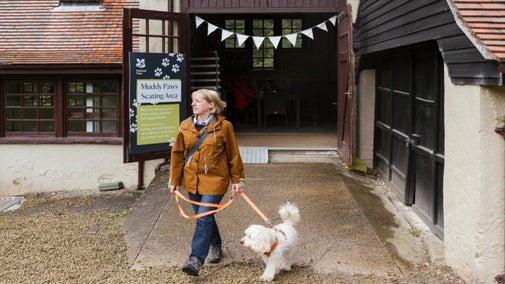
Discover more at Morston Quay
Find out how to get to Morston Quay, where to park, the things to see and do and more.

Morston Quay is part of the Blakeney National Nature Reserve. Here you'll find everything you need to know about bringing your canine friend to this special part of Norfolk.
We’ve been working on making it easier for you to find out how dog-friendly your visit will be before you and your four-legged friend arrive. To help with this, we've created a new pawprint rating system and given all the places in our care a rating. You can find this information in the National Trust members’ handbook.
Morston Quay is a two pawprint rated place.
These places have water bowls, dog bins and dog-friendly walks. You’ll be able to take your dog into some areas, but not everywhere. If there’s a food and beverage outlet, you can have a cup of tea with them, probably outside. Read on to discover exactly where you can take your dog.
Dogs are welcome at Morston Quay and along the local footpaths.
Please stay on the footpaths with your four-legged friends to avoid disturbance to ground-nesting birds.
You will find bowls of water available at the café. Please do ask if you would like us to refil a bottle of water for your dog. There is a ring mounted on the side of the café for you to secure you dog to if needed.
There are two dog bins available at Morston, one near the information centre just before you head up onto the bank and the other is situated at the west end of the overflow car park on the route of the North Norfolk Coastal Path.
Morston is a working quayside with vehicles and trailers coming and going, so please keep dogs on leads or under close control around the car park and quayside areas.
Many of the birds breeding on the coast, including oystercatchers, terns, redshanks, avocets and ringed plovers nest on the ground, making them especially vulnerable to disturbance.
Whilst many factors have a bearing on breeding success, human and particularly dog disturbance can have a significant impact. The presence of dogs can cause birds to leave nests and chicks, leaving them open to predation by gulls and other predators.
It is important to always keep dogs under close control and to stay away from fenced off areas. Some ground-nesting birds such as avocets and little terns are protected species and disturbing these species, even unintentionally, is a prosecutable offence.
We’ve worked with our partner Forthglade to come up with this Canine Code, which helps to make sure everyone can enjoy their day:
Our definition of close or effective control is:

Find out how to get to Morston Quay, where to park, the things to see and do and more.

We've partnered with natural pet food maker Forthglade so that you and your dog can get even more out of the special places we care for.
Discover some of the best dog walking spots for you and your canine companion at the variety of dog-friendly National Trust places around Norfolk.

If you’re bringing your dog(s) to the places we care for, you'll find information on our Canine Code and pawprint rating system, created in partnership with Forthglade, to help plan your visit.

We've partnered with natural pet food maker Forthglade to create the Dogs Welcome project, helping you and your dog(s) get the most out of the places in our care.

Enjoy freshly made food at Morston Quay café while you enjoy the view over the marshes and Blakeney Point in the distance.
